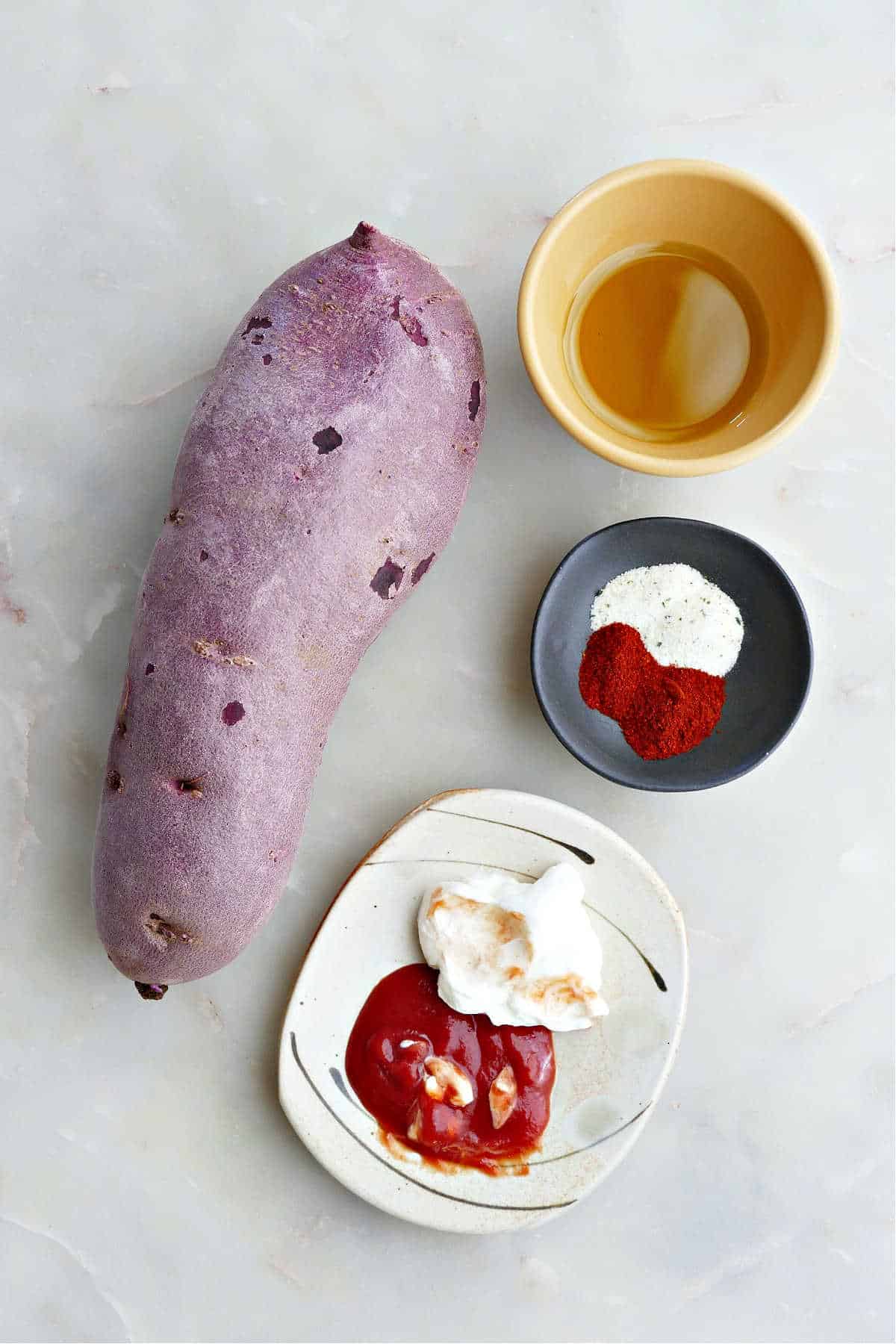Total Time Involved:
45 mins (15 mins prep, 30 mins cook)
Description:
Craving something that's crunchy, savory, and sweet? Well, oven-baked purple sweet potato fries might be for you! They're simple to make and very aesthetic. This snack or side dish also pairs well with Kewpie mayonnaise, ketchup, or really any of your favorite dips. Give it a try!
Ingredients:
-1.5 lbs purple sweet potatoes (1 very large or 2 medium)
-3 tbsp extra virgin olive oil (can sub avocado oil)
-1 tsp garlic salt (can sub garlic powder to decrease sodium)
-1 tsp smoked paprika
-Flaky sea salt (for serving)
-For dipping sauce: 3 tbsp plain Greek yogurt, 3 tbsp ketchup, and 1/4 tsp smoked paprika, garlic powder, and onion powder
Instructions:
1. Preheat oven to 425°F. Line a large baking sheet with parchment paper and set aside.
2. Scrub potatoes clean and peel. Leave the skin on if you want extra crispy fries. Cut potatoes into 1/4-inch sticks.
3. Transfer sliced potatoes to the lined baking sheet. Drizzle with olive oil and mix with your hands until coated.
4. Sprinkle paprika and garlic salt on oiled fries. Mix with your hands again. Spread fries out in a single layer on the baking sheet, making sure they don't overlap.
5. Bake in oven for 15 minutes. Use tongs or a spatula to flip the fries over. Return to oven for another 10-15 minutes until lightly browned.
6. In the meantime, whisk together dipping sauce ingredients to make a delicious sauce.
7. Serve fries warm with your sauce and sprinkled with flaky sea salt. Bon appetit!
Cooking Tips:
1. Purple sweet potatoes are denser and starchier than normal ones. Be careful not to overcook them or they may dry out!
2. Don't forget to line your baking sheet with parchment paper or a silicone mat to prevent your potatoes from sticking.
3. If using a rimless baking sheet, decrease your baking time by a few minutes. But regardless, always check on your fries every 5 minutes after flipping!
4. To store, keep leftovers in an airtight container in the fridge for 2-3 days. Reheat in a skillet with some olive oil over medium-low heat for best results.
Sample Imagery:






Recipe Website Inspiration:
1. BuzzFeed's Tasty: Users have an extremely wide variety of recipes to choose from, each accessible via simple categories (e.g., popular, diet). Recipes are also easy to read-through and information is presented (e.g., ingredients and preparation) in an efficient, 2-column format when viewing in full-screen. Tasty also attempts to promote the excitement and fun of cooking through its colorful, upbeat color scheme (e.g., a sky blue and bright magenta).
2. Tiffy Cooks: Site feels very personal, showing Tiffy's story exploring the world of cooking (e.g., each recipe has personal commentary). Site also features many areas to explore besides recipes (e.g., travel blogging) and incorporates video content to further engage users. Overall, site is very engaging and promotes a close relationship between the user and the cook.
3. Minimalist Baker: Site features stellar photography and stunning video clips to accompany detailed recipes. Users may also leave recipe reviews, adding interaction between users and the site. The overall web design is very clean and minimalistic, making for an easy viewing experience.
Non-Recipe Website Inspiration:
1. Reformation: Similar to Minimalist Baker, Reformation really sells its products via usage of skilled photography. Pictures help lead the user's navigation of the products and are paired with simple, sans-serif type. Users may also filter results using intuitive filters, strengthening the usability of the site.
2. innisfree: Site also maintains a high emphasis on photography, using cut-outs of products paired with a uniform color scheme to create intriguing web designs. Users may also easily explore products by filtering by useful categories (e.g., by concern, by key ingredient).
3. Pinterest: Pinterest's user experience promotes creativity, simplicity, and ease. By showcasing a ton of relevant content, following a simple concept (e.g., adding pins), and placing emphasis on the feed structure, users aren't confused about the service's intended function.